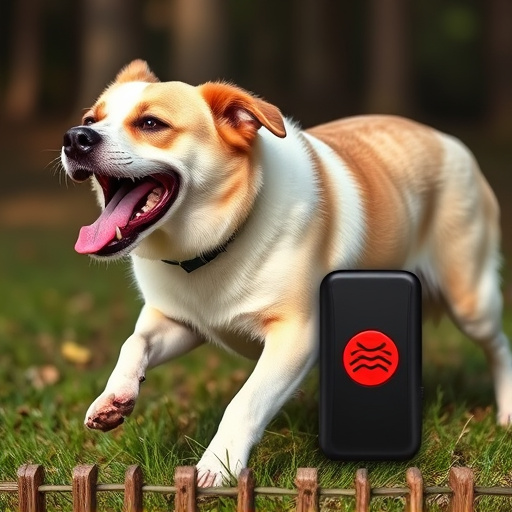Ultrasonic bark control devices, a humane dog training solution, emit inaudible sound waves to stop barking. Choosing the right device requires considering dog size, hearing sensitivity, and environmental noise. Devices operate within 25-64 kHz for most dogs, with higher frequencies for smaller breeds and lower for larger ones. A detailed Ultrasonic Bark Control Device Comparison reveals various options with adjustable settings, motion sensors, water resistance, easy setup, and long-lasting batteries. These features ensure effective, non-lethal control of unwanted barking while prioritizing pet well-being.
“Unleash a peaceful environment with an effective dog repeller! If you’re seeking a solution to manage canine disturbance, this comprehensive guide is your compass. We delve into the world of Ultrasonic Bark Control Devices, exploring their mechanism and the crucial role of frequency range in their effectiveness.
Our article offers a detailed look at the top brands, their unique features, and provides an insightful Ultrasonic Bark Control Device Comparison table based on frequency and performance. Discover the secrets to choosing the perfect dog repeller for your needs.”
- Understanding Ultrasonic Bark Control Devices
- Key Factors in Effective Frequency Range Selection
- Top Dog Repeller Brands and Their Features
- Comparison Table: Ultrasonic Bark Control Devices by Frequency Range & Effectiveness
Understanding Ultrasonic Bark Control Devices
Ultrasonic Bark Control Devices are a popular choice for dog owners seeking non-lethal methods to train and control their pets’ barking. These devices emit high-frequency sound waves that are inaudible to humans but can be detected by dogs, triggering an instinctive response to stop barking. When a dog barks excessively, the device activates, emitting a high-pitched tone that quickly fades away if the dog ceases barking. This approach offers several advantages over traditional training methods; it’s humane, effective for various breeds and sizes of dogs, and can be easily adjusted to specific sensitivity levels.
In terms of Ultrasonic Bark Control Device Comparison, there are numerous options available on the market, each with its unique features and frequency ranges. Some devices operate within a narrow range, while others cover a broader spectrum. The effectiveness of these tools often depends on factors like dog size, hearing sensitivity, and environmental noise levels. For instance, smaller breeds might require higher-frequency settings, whereas larger dogs may be more responsive to lower frequencies. Understanding these nuances is key to choosing the right device that caters to specific needs, ensuring both effective barking control and the well-being of your pet.
Key Factors in Effective Frequency Range Selection
When considering an ultrasonic bark control device, understanding the frequency range is paramount to its effectiveness. Different dogs have varying sensitivity levels to ultrasound, making it crucial to select a device that operates within the optimal frequency spectrum. Generally, frequencies between 25 and 64 kHz are effective for repelling dogs without causing harm or discomfort.
An ultrasonic bark control device comparison reveals that higher frequencies (above 64 kHz) might be more suitable for smaller breeds with more delicate hearing, while lower frequencies (below 25 kHz) could be better for larger dogs known for their robust hearing. The right frequency range ensures the device is both humane and efficient in training unwanted barking behavior.
Top Dog Repeller Brands and Their Features
When it comes to effective dog repellents, several top brands stand out for their innovative features and technological advancements. Among them, ultrasonic bark control devices have gained popularity due to their non-lethal and humane approach to keeping dogs away from unwanted areas. These devices emit high-frequency sounds that are unpleasant to dogs but virtually imperceptible to humans.
A Ultrasonic Bark Control Device Comparison reveals a range of options catering to different needs. Some brands offer adjustable frequency settings, allowing users to customize the intensity based on their preferences and surrounding environments. Others incorporate motion sensors for more targeted activation, minimizing false triggers. Top-rated models also include features like water resistance, easy setup, and long-lasting batteries, ensuring convenience and reliability in various weather conditions and outdoor setups.
Comparison Table: Ultrasonic Bark Control Devices by Frequency Range & Effectiveness
When considering an ultrasonic bark control device, understanding the frequency range and its effectiveness is key to making an informed choice. These devices emit high-frequency sound waves that are unpleasant to dogs, encouraging them to stop barking. However, not all frequencies are equally effective. A comprehensive Ultrasonic Bark Control Device Comparison reveals significant variations in both frequency ranges and results.
Some models operate within a narrow band of 25-64 kHz, which is within the range of human hearing but perceived as high-pitched squeals by dogs. While this can be effective for light barking, it may not deter more persistent or deep-throated barks. Other devices cover broader spectrums, expanding from 3-50 kHz or even up to 100 kHz, ensuring that the sound is inaudible to humans but still disruptive to canine hearing. This broader range makes them suitable for addressing more severe barking issues. Additionally, product reviews highlight varying levels of effectiveness based on factors like device sensitivity, bark detection algorithms, and range, offering valuable insights for consumers seeking the most reliable solution.
When selecting an ultrasonic bark control device, understanding the importance of its frequency range is key. This comprehensive guide has illuminated the critical role frequency plays in effective dog repeller performance. By considering factors like environment and pet size, you can make an informed choice from top-rated brands. Refer to our detailed comparison table for a side-by-side analysis of various models based on frequency range and effectiveness, helping you choose the best ultrasonic bark control device for your needs.
